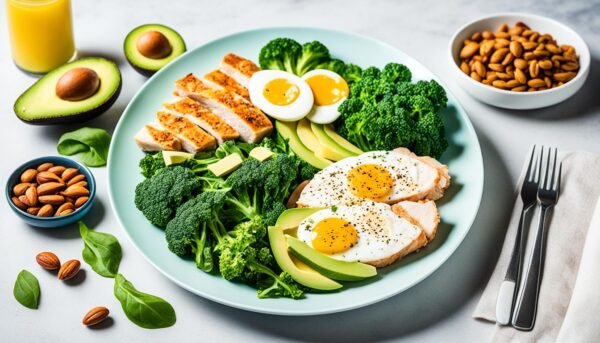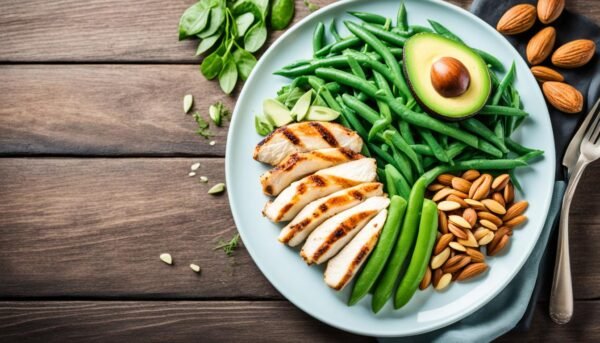Have you ever wondered, is your carb intake truly low enough to get the benefits of a low carb diet? It’s a common question. The answer, though, can be complex. When on a low carb diet, knowing the right carbohydrate intake levels is key. It helps to reach your goals, like losing weight, better metabolic health, or getting into ketosis.
In this article, we’ll look into carb restriction. We’ll focus on the numbers for a truly low-carb lifestyle. I’ll explain the science of carb counting, from the ketosis threshold to the metabolic benefits range. This information will help you make smart decisions on your health journey.
Understanding Low-Carb Diets
I’m into ways to be healthier, so I’ve looked into low-carb diets. These plans cut down on carbs and focus on more protein and good fats.
What is a Low-Carb Diet?
A low-carb diet means eating fewer carbs. This often looks at how fast carbs turn to sugar, not just how many carbs there are. When you eat fewer carbs, your body might start using fat for energy. This change is called ketosis. There are diets like keto, Atkins, and others that focus on low carbs and more fat.

Low-carb diets usually include foods like veggies, some fruits, lean meats, eggs, and more.
Benefits of Low-Carb Diets
These diets are good for fighting obesity, type 2 diabetes, and bad metabolism. By eating fewer carbs, they help you lose weight and bring down your blood sugar. They can also make your heart healthier and lower inflammation.
Sticking to a low-carb diet for the long haul is hard but important. You might see good changes in your health at first. But, keeping these benefits needs you to stay focused on eating well.
Defining Low-Carb: The Carb Intake Range
Starting a low-carb diet means you need to know how many carbs to eat. Most experts say a low-carb diet is 100 grams or less of carbs each day.
Less than 100-150 Grams per Day
Eating under 100-150 grams of carbs daily has many perks. You might lose weight, control blood sugar better, and boost your metabolism. Yet, the effects can differ for each person.
Below 50 Grams for Ketosis
To get into ketosis, eat less than 50 grams of carbs daily. In this state, your body uses fat for energy instead of carbs. It’s a big change for your body.

Following a ketogenic diet can be hard but it’s worth it for many. It can bring big weight loss and health improvements for those who stick to the plan.
Calculating Net Carbs
Counting net carbs is key in a keto diet. It’s important for ketosis. Net carbs are carbs that affect blood sugar, a big deal for low-carb diets.
Subtracting Fiber and Non-Digestible Carbs
To find net carbs, subtract fiber, sugar alcohols, and certain carbs. These carbs don’t spike blood sugar.
Here’s the math for net carbs:
- Check the nutrition label for total carbs.
- Find the amount of fiber, sugar alcohols, or non-digestible carbs.
- Subtract these from the total to get net carbs.
For instance, a food item has 20 g total carbs, with 5 g fiber and 3 g erythritol. The net carbs would be 12 g (20 g – 5 g – 3 g).
Choosing foods by net carbs helps on a keto diet. It lets you control carbs well and stay in ketosis.
Common Mistakes on Low-Carb Diets
Starting a low-carb diet has many health benefits. But there are mistakes to watch out for. Eating too much protein, avoiding good fats, and ignoring balance in minerals are common errors.
Eating Too Much Protein
Eating too much protein is a common setback. When you cut carbs a lot, protein may change to glucose. This can stop ketosis. You should eat moderate protein, aiming for about 0.7-0.9 grams per pound.
Being Afraid of Healthy Fats
It’s key to swap carbs with healthy fats. Not doing this can make you hungry, lack nutrients, and have less energy. There’s no reason to fear fats like monounsaturated and omega-3 on a low-carb diet. They keep you full, give you key nutrients, and boost your health.
Not Replenishing Sodium
Low-carb eating makes you lose extra sodium. This happens because your insulin goes down. You might feel dizzy, tired, or get cramps. Adding salt to your food or drinking broth helps. It keeps your minerals in check and makes you feel better on the low-carb path.
How Many Carbs Are Considered Low
Starting a low-carb diet means knowing carb limits are vital. How many carbs you eat affects what health goals you can reach. It also impacts your body’s main way of getting energy.
Very Low-Carb: Less than 20-50 Grams
A very low-carb diet means eating under 20-50 grams of carbs a day. This level is key for getting to and staying in ketosis. In ketosis, your body switches to burning fat for energy. This can help you lose weight and might be good for your health.
Low-Carb: Less than 130 Grams
Most research defines a low-carb diet as having less than 130 grams of carbs daily. It’s lower than many people normally eat. This eating style can lead to weight loss and better health numbers. It’s not as strict as very low-carb, but it’s still a good choice.
Moderate-Carb: 130-220 Grams
A moderate-carb diet lets you eat 130-220 grams of carbs a day. This amount fits the standard advice for carbs. For some, this is easier to stick with than very low amounts. This middle-ground diet may not have as strong benefits, but it’s better for health than lots of carbs.
Incorporating Good Carbs
Following a low-carb diet taught me to use nutrient-dense carbs from healthy places. It’s about eating fewer carbs, but at the same time, picking healthy carb sources. These types give me what I need, like vitamins, fiber, and energy, without the bad stuff.
My favorite nutrient-dense carbs are brown rice, whole-wheat food, and oats. I also love quinoa, spinach, and sweet potatoes. These foods are high in fiber, vitamins, and antioxidants. They are key to my way of eating.
Going for the right healthy carb sources means my blood sugar stays more even. The fiber and protein in these foods do the trick. They slow how quickly sugar gets into my blood. This keeps me full, stops hunger, and means I don’t eat too much.
Source Links
- https://www.healthline.com/nutrition/5-most-common-low-carb-mistakes
- https://www.medicinenet.com/what_is_considered_low-carb/article.htm
- https://www.webmd.com/diet/news/20240207/what-counts-as-low-carb-diet
This post may contain affiliate links which means I may receive a commission for purchases made through links. I will only recommend products that I have personally used! Learn more on my Private Policy page.